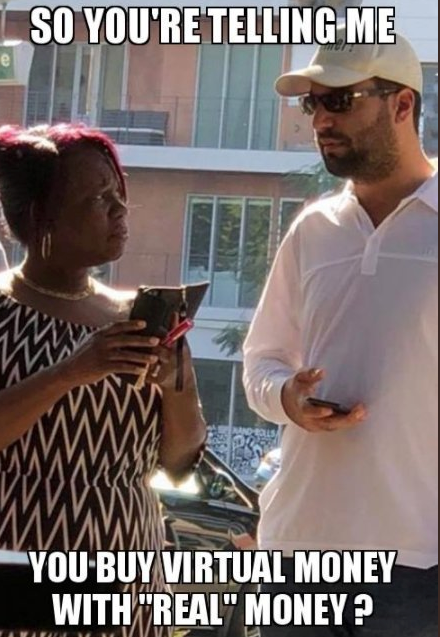Crypto markets in Q1 of 2018 have been brutal, unforgiving, and downright cruel to people who may have entered at all-time highs in December of 2017.
These markets have done a fantastic job of eliminating “new money” entering purely to turn a profit (much like everyone else in earlier months) and separating the weak hands from stronger hands. However, it’s going to be hard convincing those same people to re-enter these markets with current portfolio’s down over 70% in some instances.
I was fortunate to sell 80% of my crypto holdings in January of 2018 locking in serious profits and doing my best to hedge against the bear cycle I saw coming.
My calls were solid and I’ve grown in experience and confidence playing financial markets. The de-briefing process which I’m about to share below is just as important for me to come back to down the road and evaluate as it is for you to read right now. Let’s begin.
Liquidated 80% of my crypto portfolio tonight. Gains over the past year have been unreal. Large portion of USD will pay down mortgage + loans on rental properties, saving hundreds of thousands in interest + purchase another rental, maybe two this year.
— Nick Cuttonaro (@NickyPapersNY) January 25, 2018
1) Knowing When & Why You Should Sell Crypto Positions:
In 2017, there was a strong emphasis on buy strategies. More specifically, buying dips, dollar-cost averaging, controlling position size, and diversification across a variety of crypto assets. It was rare to find people who were advocates of selling, sharing publicly they’ve sold positions, or have shown any indication of uncertainty alluding to a shift toward entering a bear market in the near future.
The reality is that many people who entered these markets never set financial goals or put a game plan in place to de-risk a profitable position and extract profit or limit loss in the event the trade goes horribly wrong. Too many people bought into HODL mentality, which can often be a juvenile approach leaving many wishing they sold earlier to limit loss.
Other than real estate and equity positions in companies I own and control, it’s hard for me to look at anything which can be traded easily on an exchange as a long-term investment.
While I might believe the technology will be relevant in the future, I’ve done a good job separating myself from long-term expected outcomes in the area of blockchain technology vs. current and near-future market conditions.
I sold 80% of my portfolio in January of 2018 because I had a game plan which was tailored specifically to my financial goals which also impacted other asset classes I have exposure to (real estate) for the better.
Many are hurting now because they never saw market prices reversing, never considered the possibility of a bear market, never set goals and targets, and never took a moment to close their eyes to picture what the future might be like a few months down the road.
Much like any other industry, you or your company will need to sell to survive. The same rules apply in crypto markets which shouldn’t be a surprise.
For those who considered my stance on #cryptocurrency markets and rebalanced, great. There's another elephant in the room, the stock market. I've had a hell of a run from Brexit until now and pulled 80% of my equities holdings out this week, back to cash to de-risk.
— Nick Cuttonaro (@NickyPapersNY) February 4, 2018
2) Conditions In Other Financial Markets Matter:
After selling 80% of my crypto holdings in January, I sold 80% of my equities portfolio on February 1st 2018. When I realized many of the same people are playing in both crypto and equities markets I realized humans will act as humans do during times of uncertainty.

Look at the charts for BTC and DJIA, similar patterns. There are parallels as both markets experienced parabolic characteristics, defined peaks, and have continually tested lower highs where there’s evidence of a bearish trend line. There may still be fantastic short-term trade opportunities in both markets but for a long-term passive investing approach, the risk/reward profile for continuing to invest using the same 2017 strategies may not be the best approach to survive and thrive.
I see things becoming worse in both markets before they become better. I’ve felt that way for a while. More on market correction insights can be found in my November 2017 post.
Not long ago, people were concerned about paying tax on crypto gains.
Many held so taxable events wouldn’t be created.
Making trading decisions based on tax considerations is foolish.
PS – January ended up being fantastic to sell to deal with tax liabilities in 2019.
— Nick Cuttonaro (@NickyPapersNY) March 30, 2018
3) Smart Trading Should Be Prioritized Over Tax Optimization Strategy:
One of the worst approaches is trying to time market conditions to control short-term vs. long-term capital gains taxes by paying too much attention to holding durations. If you’re in a position where it makes sense to sell, consider selling.
People may regret not selling when they had the chance to profit and pay taxes vs. holding their portfolio or a large position at a major loss where there’s no taxes to pay because there’s now no profit to be realized.
If you’re looking to offset capital gains through booking losses, the IRS has set a limitation of $3000 of losses per tax filing which can be declared against ordinary income.
For serious traders and ICO investors, the meager amount of $3000 of leeway from the IRS to be used to offset losses will not get you out of an uncomfortable financial situation.
Also, businesses who perpetually operate at a loss or deliberately spend without care to zero out profits in an effort to pay as little tax possible will eventually get crushed when financial uncertainties prevail. Taxes are part of a sound business, life, and smart trading.

4) Cash Is Still King:
Once the wave of cryptocurrency took over and demonstrated a new way to transact with people and businesses in 2017, cash (as a currency) was snubbed and wrote-off as antiquated as “cryptocurrency is the future”.
While cryptocurrency certainly is the future, it’s important to realize that one of the main on-ramps (as well as exit-ramps) to cryptocurrency markets is through fiat currencies.
Most important, we’re still pegging the value of Bitcoin to USD (or your local fiat currency) so when the value of Bitcoin “goes down”, the pain you’re experiencing is tied to the perceived stability, attachment, and interpretation of what fiat currency means to you.
The reality is that 1 Bitcoin still remains 1 Bitcoin, despite what market prices in USD display at any given time. Why is this important? Perhaps, we’re not mentally prepared as a society to shift to a decentralized digital ecosystem as a means of exchange right now.
Perhaps, the current financial system as we know it isn’t as broken as we make it out to be. Perhaps, we’re not all experiencing the level of pain and uncertainty on a global level (Venezuela) where government controlled currency falls short and fails citizens.
The more we think in absolutes, the more we tend to embrace or reject concepts based on personal biases and how we feel at particular times. For example, if you made money trading Litecoin and watched it rise from $30 to $300 per coin in 2017 it’s easy to say “this is the future of money” or “Litecoin will be used for day-to-day purchases in the future”.
However, if you bought Litecoin at $320 in December and watched it go down to $120 per coin in March of 2018 it’s easy to argue that “Litecoin is too volatile to become a widely accepted currency” or “cryptocurrency sucks”.
While I believe blockchain is the perfect application for a transactional economic system, I’ll always be a speculator first. On the flip side, I’m aware of how powerful the underlying technology is and how valuable the finite supply of Bitcoin might become which is why I’ve elected not to sell the remaining 20% of my crypto holdings after liquidating in January as I see exposure to crypto asset classes important (regardless of market pricing) where I believe I can use those funds for a meaningful purpose down the road.
5) Cash Money Still Remains The Ultimate Privacy Currency:
There was such an emphasis in 2017 on the privacy elements of certain cryptocurrencies it was easy to overlook how easy it is to track wallets, determine wallet ownership from amateur wallet management practices, and never consider why the average person would need to utilize a “privacy coin”. With public ledgers, it’s easy to follow the money.
While cash is expensive to print and manufacture (literally) and we’re using less cash as a society, physical currency might become more of a valuable commodity than ever before.
The inherent privacy elements cash money provides, the fungibility, coupled with growing scarcity, makes it a fantastic instrument to have exposure to in your portfolio.
Cash is remarkable because we have an emotional connection with it. You can touch it, smell it, throw it around, rubber-band stacks, hear change jingle, or neatly organize bills in your wallet with the largest denominations in the back while keeping the singles up front.
Flexibility in mindset is important to accept cash might be falling out of style with the dominance of credit, debit, and online transactions but it’s still a functional privacy currency. There’s nothing wrong with having exposure to Monero or Zcash in your crypto portfolio but the ultimate hedge might be cash money held as physical currency.

6) Tune In While Other People Are Tuning Out:
“The best way to predict the future is to create it.” Wise words shared by Evan Luthra hold true, especially during the current bearish market conditions we’re experiencing now.
While I haven’t fired off a trade since January as risk vs. reward profiles are not where I’d like them to be, I’ve still remained active within the markets by launching a podcast on Bitcoin.com, gathering intel through phone conversations with other traders, staying active by researching new blockchain projects, tuning in daily to Carter Thomas’s YouTube channel, and attending industry conferences to build my personal network.
Spending time away from the charts in Q1 of 2018 allowed me to focus on growing other businesses and spend energy on increasing revenue and profit in other areas.
7) Long-Term Wealth Building Should Be Your Top Priority:
My exit strategy for crypto and trading equities is real estate. More specifically, taking both principal and profit off the table and investing in income producing assets creating a compounding machine to support the purchase of more real estate.
Real estate is awesome from a depreciation perspective to reduce tax liabilities. Also, shelter is a core need for humans and there’s a finite supply of earth to build upon.
Rental property investments excite me and have proved to be a reliable and high-yield investments which can be obtained with leverage.
2017 was unique for crypto markets where operating with rigid rules (i.e. trading into free positions) worked reliably. 2018 is a different story and using old strategies in new market conditions will likely lead to getting burned especially if you don’t have your “why” in place.
For crypto in 2018, my focus has been on limiting losses as much as possible and limiting trade frequency. If I’m not seeing a trade worth making until Q3 or Q4, that’s OK. As we’ve seen before, it’s possible to generate astronomical gains in a short period of time.
Like any other business, I’m treating trading like a business and profits generated are rolled into a long-term wealth building strategy through real estate.
There’s a quote which stuck with me from the ESPN series 30 for 30 (“Broke”) by Steve Bisciotti, billionaire and the owner of the Baltimore Ravens.
Quote: “You can live like a king for a while, or you can live like a prince forever.”
Everyone should watch “Broke” in the video above, it definitely puts being rich vs. creating long-term wealth into perspective. Cheers!



































